Focal Length Defines Which Of The Following Camera Qualities?
East very pick you make as a filmmaker will alter your footage. Some choices are bigger than others, one of which is f ocal length.
What is focal length? It's a measurement that specifies how your lens interacts with your photographic camera. On a applied level, focal length determines field of view, or how much of a view will exist captured . It too indicates how large subjects and elements in that view will be, or the magnification.
In this article, we'll explain information technology in detail. We'll expect at different lenses and focal length examples. You'll come abroad knowing why focal length matters, and how and when to use a variety of focal lengths to generate intended feelings.
Watch: Ultimate Guide to Camera Lenses
Subscribe for more filmmaking videos like this.
Tabular array of Contents
Everything y'all need to know near Focal Length.
- Understanding Focal Length
- Focal Length Essentials
- Wide-Angle Lens (23mm-35mm)
- Standard Angle Lens (35mm-55mm)
- Long-Focus Lens (55mm-500mm)
- Field of View
- Creative Uses of Focal Length
- Compress Space
- Expand Space
- Capture Action
- Exaggerate Movement
- Move the Camera
1
Understanding Focal Length
THE Basics OF LENS FOCAL LENGTH
one.one FOCAL LENGTH ESSENTIALS
The nuts of lens focal length
Your photographic camera and lens are the audience. Your audience sees no more and no less than what you lot show them. It is crucial that when telling your story, you consider all the aspects of visual storytelling for your pic.
All the small creative storytelling choices that you make for each image of your film are important. These small choices coalesce into the powerful furnishings your audition will feel as your story unfolds before them.
Focal length affects how "zoomed in" an image appears. The college the millimeter (mm) number, the more than "zoomed in" the image appears.
Focal length is measured as the distance from the focal betoken where light rays converge in the lens to the sensor or flick in the camera, as illustrated in the diagram beneath.
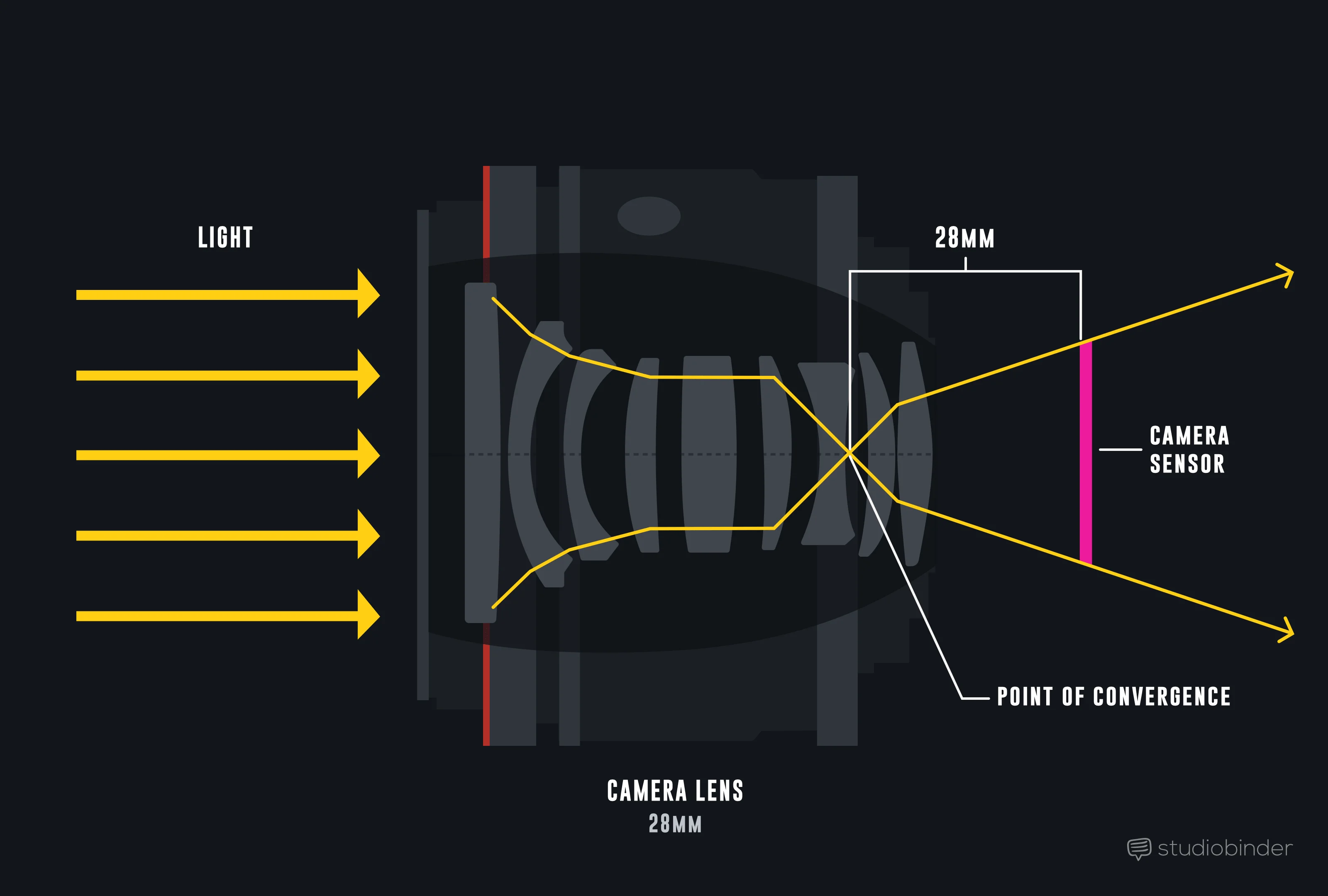
The measurement from the focal signal, or point of convergence, to the sensor or film
Your shot begins with the focal length of your lens. Here's a more detailed focal length meaning:
FOCAL LENGTH DEFINITION
What is focal length?
Focal length is the distance betwixt the optical heart of the lens, and the camera sensor or moving-picture show plane when focused at infinity. The optical center is where light rays converge within the body of your lens. The focal length defines the magnification and field of view for a given lens. This value is almost commonly measured in millimeters. Prime lenses take set focal lengths whereas zoom lenses have variable focal lengths, and any alter alters the visual properties of your footage.
Why is focal length so important?
- Dictates your field of view (what is in frame)
- Generates visual context for your shots (how we feel)
- Alters the visual properties of your shots (how it looks)
"Which size lens do you want to shoot this with?"
At times yous may hear someone use the term lens size, which is the same affair as the focal length. Very rarely will y'all hear someone respond to the question with something general like standard lens or long lens. More than ofttimes you will hear the specific mm value.
When it comes to narrative filmmaking, your focal length will let you to capture footage with different visual properties based on your lens pick.
The difference is obvious
There are both practical and creative consideration when making these decisions, so agreement focal length might exist the most of import visual tool for a director to embrace.
A longer focal length, such as 135mm or 85mm in the diagram below, results in a narrower bending of view and greater magnification. Meanwhile, a shorter focal length, such as 24mm or 14mm, translates to a wider angle of view and less magnification.
In this commencement example, below, the camera is positioned the aforementioned altitude from the subject area and different lenses are used:
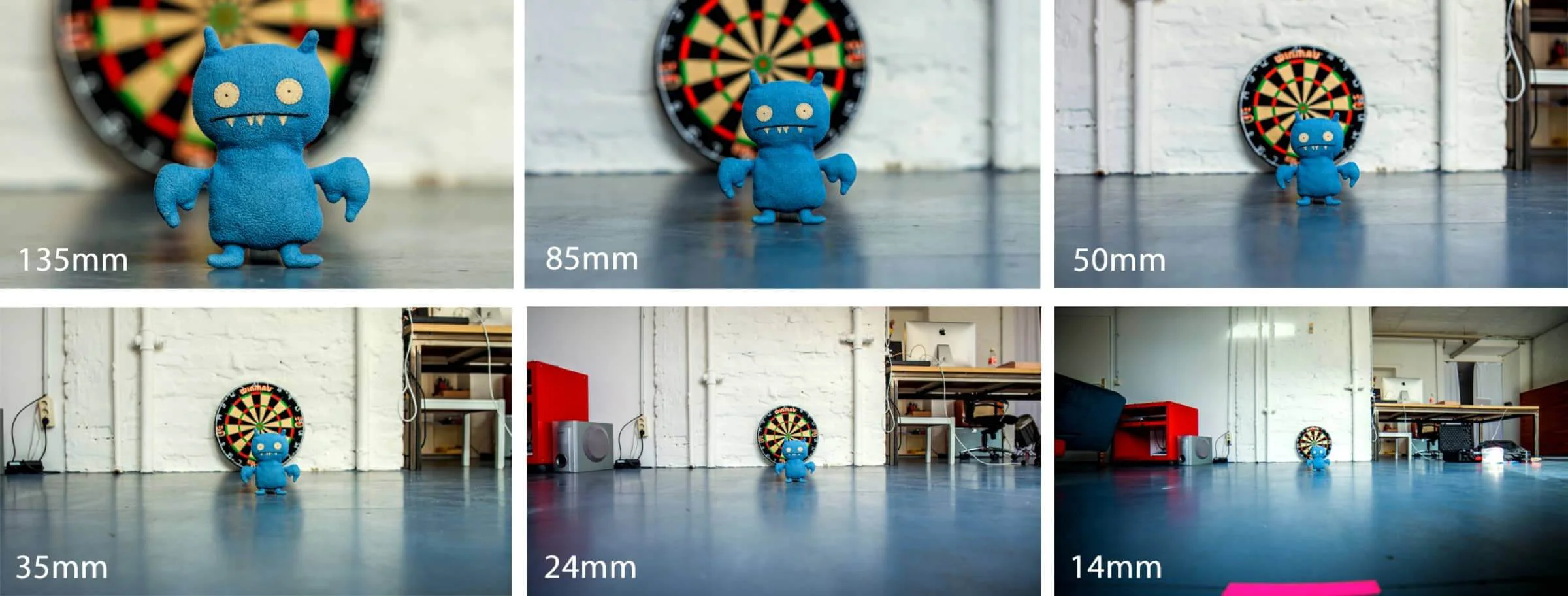
Aforementioned distance, different effects
In the next focal length example, the photographic camera is positioned at varying distances with different lenses, as indicated in each photo:
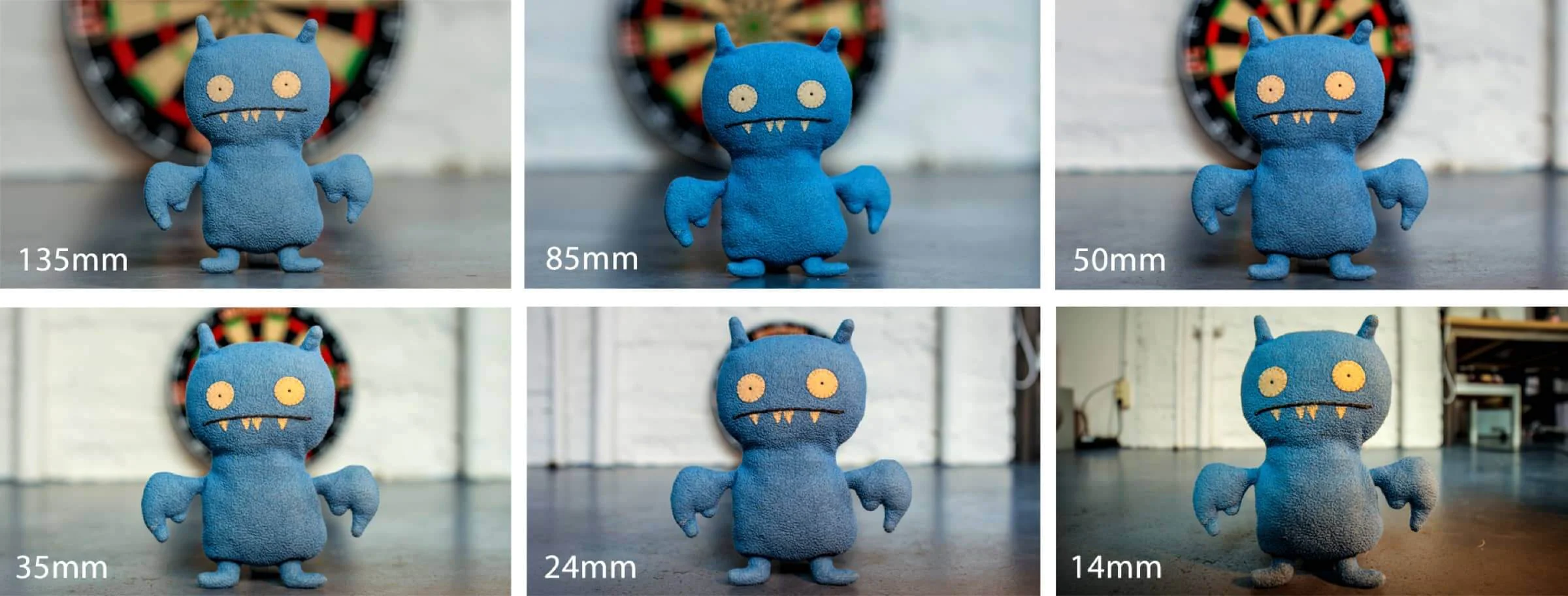
Unlike distance, different effects
So think:
The lens mm number refers to the focal length or magnification. This can too be casually referred to every bit the lens size.
In StudioBinder, you tin easily select the lens' via your shot specs column. Take a wait below to see information technology in activeness:
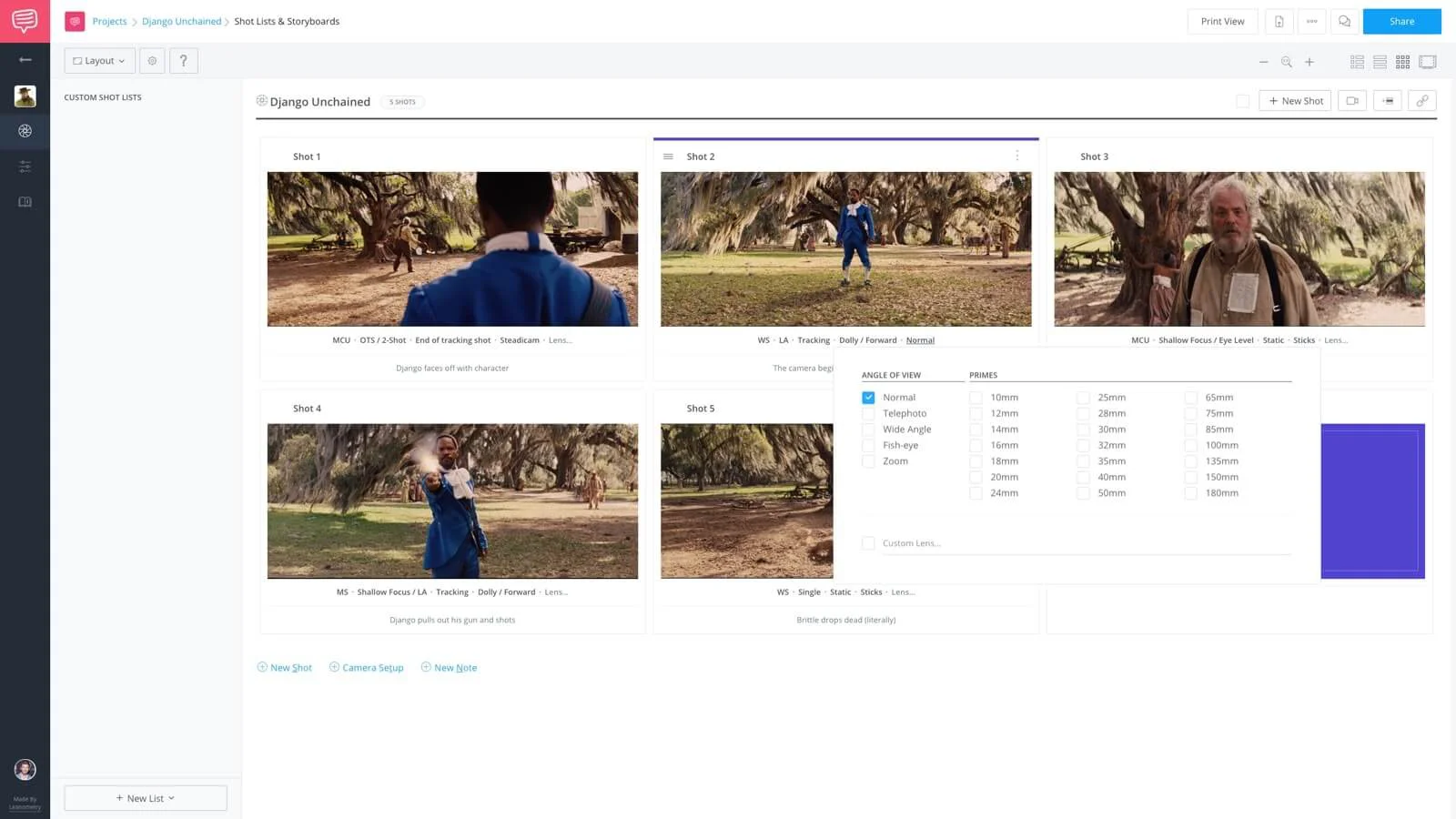
View the diverse options yous tin pick
Before we get into the different focal lengths, take a infinitesimal to download our FREE Ebook — Camera Lenses Explained Vol. 1 — where cover everything you need to know about the dissimilar types of camera lenses, their unique visual characteristics, and how to employ them.
Costless downloadable bonus
FREE Download
Camera Lenses Explained
Every type of photographic camera lens has distinct qualities and visual characteristics that every image-maker should understand. Download our Complimentary e-book to get in-depth explanations on prime vs. zoom lenses, anamorphic vs. spherical lenses, broad angle, standard, telephoto and even specialty lenses that all tell a slightly different story.
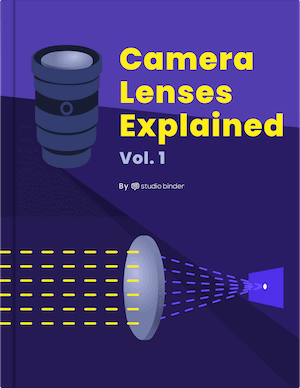
1.ii Lens FOCAL LENGTH
Wide-Bending Lens (23mm-35mm)
A wide-bending lens is any lens with a set focal length that is shorter than the length of the sensor or motion picture (measured diagonally). For a full frame sensor, your wide-angle focal length would be anything beneath 35mm.
Wide angle lenses explained, with broad angle lens tests
Often any lens with a focal length that falls between 23mm and 35mm tin can be categorized as a wide-angle lens. To get down any lower than 23mm would still exist considered wide-angle, but it pushes the lens into fisheye territory.
FISHEYE LENS Definition
what is a FISHEYE LENS?
A fisheye lens is an ultra wide-bending lens (often called a super wide-bending lens) that captures an extremely wide image, more often than not around 180 degrees.
Fisheye lenses produce distorted, curved images. As the name implies, a fisheye lens is based on how a fish would view things below the surface of the water.
Whatever broad-angle lens with a focal range of 1mm to 23mm tin can be labeled a fisheye lens. They are often used to shoot buildings, large rooms and open up spaces, and birds-eye views, every bit they curve straight lines to dynamic effect. Fisheye lenses are likewise popular for creating funny, warped images, such as close-up shots of faces.
ane.3 Photographic camera FOCAL LENGTH
Standard Lens (35mm-55mm)
A standard lens has a set (prime) focal length that is around the same length equally the sensor or picture (measured diagonally). For a full frame sensor, your focal length would come in right around 42mm.
Often a lens falls between 35mm to 55mm tin be categorized as "standard" focal length.
Standard lens exam
Standard lenses are purported to have a similar field of view to that of the human eye, though this has been disputed considering that the human eye has a truthful field of view closer to that of a 17mm to 25mm lens, with a f/three.2 aperture rating.
The true reason 35mm to 55mm are similar to the homo eye is that of our cone of visual attention, which thins the field of view of the human heart.
1.4 FOCAL LENGTH comparison
Long-Focus Lens (55mm-500mm)
A long-focus lens is whatever lens with a set up focal length that is significantly longer than the length of the sensor or pic (measured diagonally). For a full frame sensor, your focal length would exist anything higher up 55mm.
Long-focus lens test
Oftentimes whatsoever lens that falls betwixt 55mm to 500mm tin can exist categorized as a long-focus lens. You may hear a cinematographer or photographic camera operator refer to them simply every bit "long lenses."
Some long lenses are likewise telephoto lenses, simply this only occurs in a specific situation where a telephoto grouping of glass is built inside.
TELEPHOTO LENS Definition
what is A TELEPHOTO LENS?
A telephoto lens is a specific kind of long-focus lens. Its internal design provides a focal length a dandy deal longer than the length of the lens itself. Like other lenses, telephoto lenses are available in fixed (or prime) focal lengths, too equally zoom varieties.
Telephoto lenses in general take focal lengths over 70 mm, and come in dissimilar sizes. Whatever telephoto lens with a focal range of 300mm or higher would be considered a super telephoto lens.
Telephoto lenses are often used to shoot wild fauna or sports. They can make afar subjects appear closer. Also, in shut-up portrait shots, telephoto lenses tend to continue a subject'southward features in proportion, with minimal to no distortion.
one.5 FOCAL LENGTH explained
What is field of view?
Field of view is the amount of infinite you lot come across on the prototype airplane. It's how much of a scene is captured in your image.
If you were to record footage of your hero actor:
A wider lens might prove the torso, which is a larger field of view.
A longer lens might bear witness only their face, which is a smaller field of view.
To expound upon what we've discussed in section one above, a lens with a shorter focal length (i.eastward., a lower mm number) gives you a wider field of view. A lens with a longer focal length (i.e., a higher mm number) gives yous a narrower field of view.
This diagram illustrates the principle:
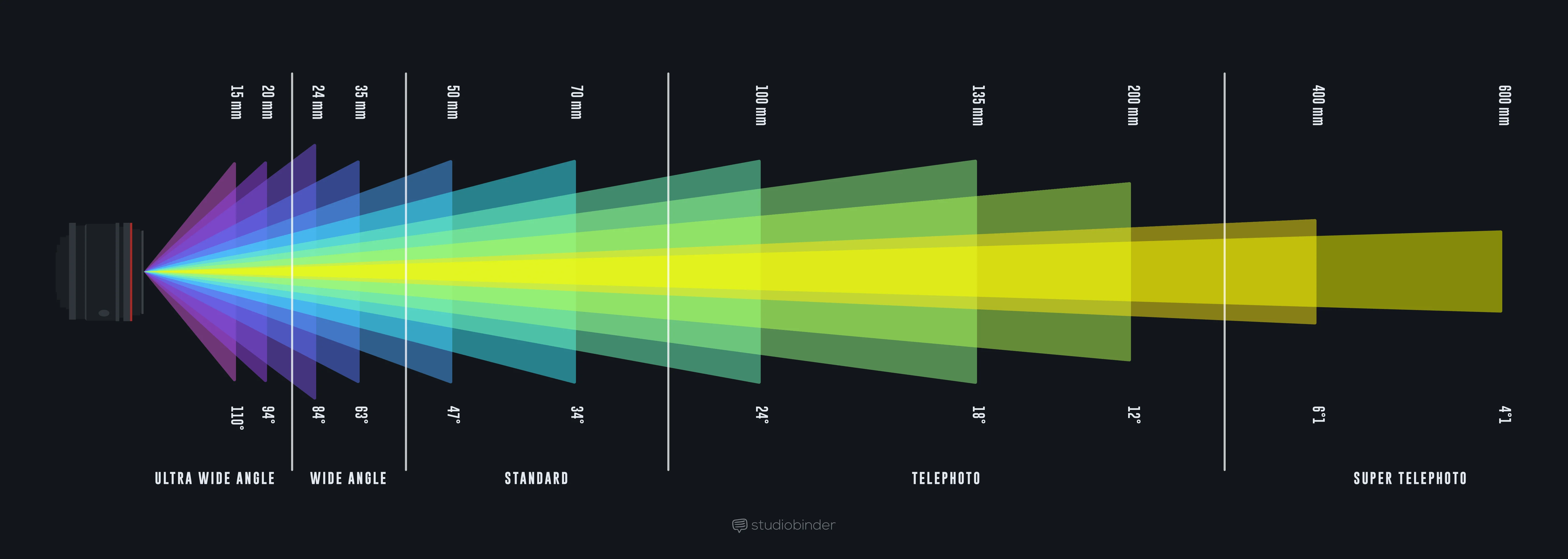
Focal length and field of view
With each shot, whatever your aim, yous'll want to characterization intended focal length in your shot list and keep track of the lenses y'all'll need on ready for a particular day.
It'due south a lot to consider, and a lot to retrieve, just planning is disquisitional. Fortunately, shot list tools brand your work easier.
Use your shot listing to go along track of the lens and intended focal length of every shot
Some films are shot entirely with wide or long lenses considering of the blazon of images they create, and in other cases directors volition elect to prove a gradual alter in a story through a gradual modify in focal length.
Check out the video below to run across how DP Roger Deakins chooses which lens to tell a particular story in every shot.
How to Cull a Lens w/ Roger Deakins • Subscribe on YouTube
Focal length might seem like a purely technical consideration, and there's a lot of detailed mechanics involved . Merely as the video makes clear, technical details like focal length and lens option exist to serve your story .
An understanding of focal length, field of view, and lenses gives you the power to orchestrate your shots and convey intended emotion. This is what we'll explore further in the next affiliate.
two
Creative Uses of Focal Length
CINEMATIC TECHNIQUES WITH LENSES
2.ane short FOCAL LENGTH
Compress Space
Longer focal lengths compress the prototype past causing the background to appear closer to the subject. This compression besides causes objects (or actors) that are behind i some other to appear closer together than they really are.
In essence, y'all tin can create a shallow depth of field and "flatten" subjects and their background by shooting from a distance with a longer focal length lens. This is a class of distortion known equally lens compression.
Y'all tin shrink infinite to achieve the post-obit results.
Build suspense
This clip from Tinker Tailor Soldier Spy is a highly exaggerated example since they used an incredibly long focal length of 2000mm. Most long telephotos unremarkably used top out at around 300mm.
This video highlights that a long focal length tin be used for interesting creative applications, such equally creating a sense of danger within this scene.
However, it likewise fills a practical application by manipulating perspective and allowing dangerous special effects, action sequences, or perhaps landing planes to be farther than they appear, eliminating risk for actors.
Focal Length and shallow depth of field in Tinker Tailor Soldier Spy
Create intimacy
Some other lens compression application is to make two characters feel closer, and therefore the shot more than intimate, such equally in this scene from The Function.
If you await at the deviation between the two shots in the scene, the ones with the longer lens make Holly and Michael feel much closer, which is appropriate in context.
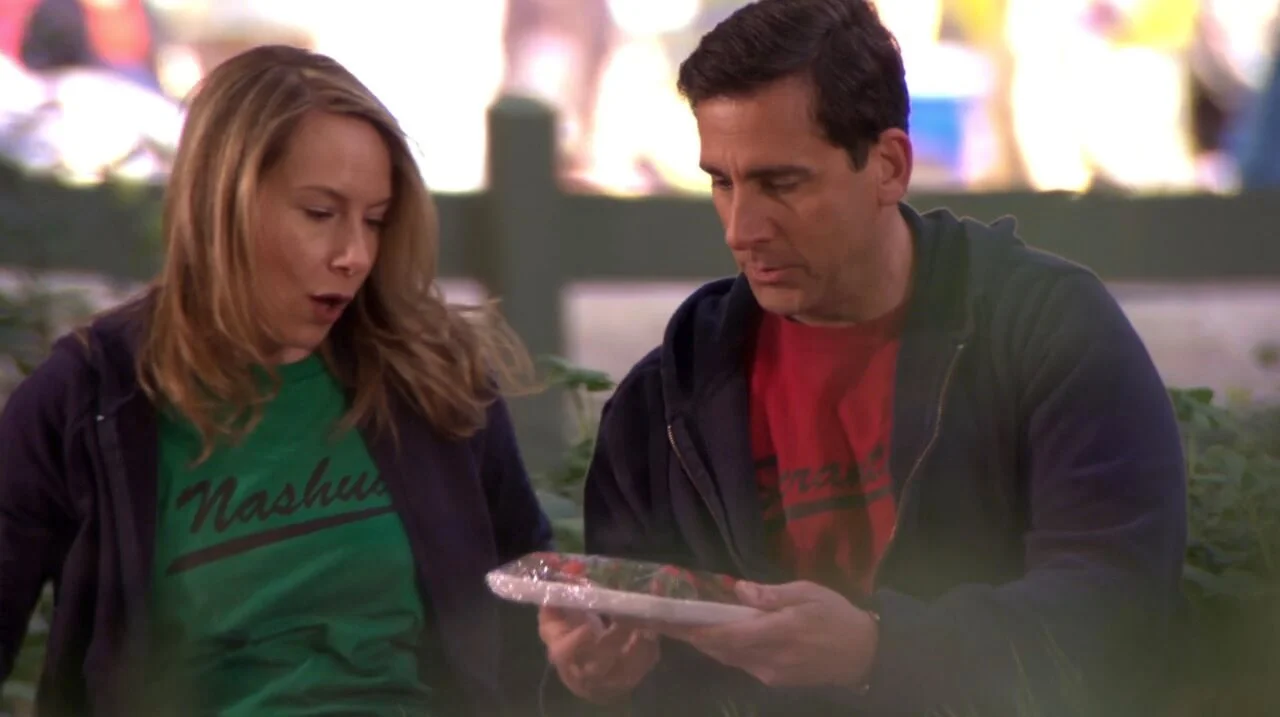
Focal length and lens compression in The Office
In this shot, Michael is reconnecting with Holly. They are only friends now, merely he'due south trying to woo her. This shot establishes the scene, simply also has some level of intimacy — as you might have noticed, the filmmakers used a long focal length to isolate Michael and Holly and drown out other distractions — their interactions here are the focus.
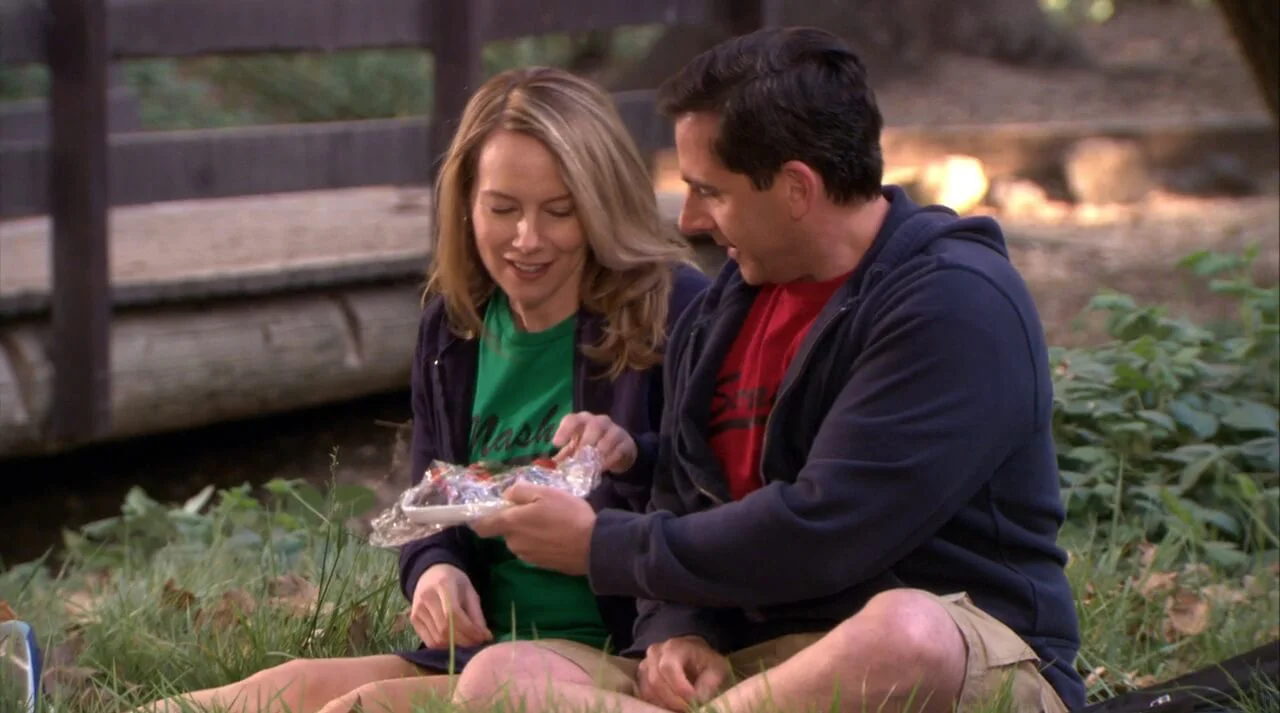
Focal Length and shallow depth of field in The Role
The filmmakers continue using a long lens hither, which makes Holly and Michael appear fifty-fifty closer than they did in the previous shot. Information technology's a very cozy image. In the final shot, the filmmakers zoom in even closer. Note the blurred background.
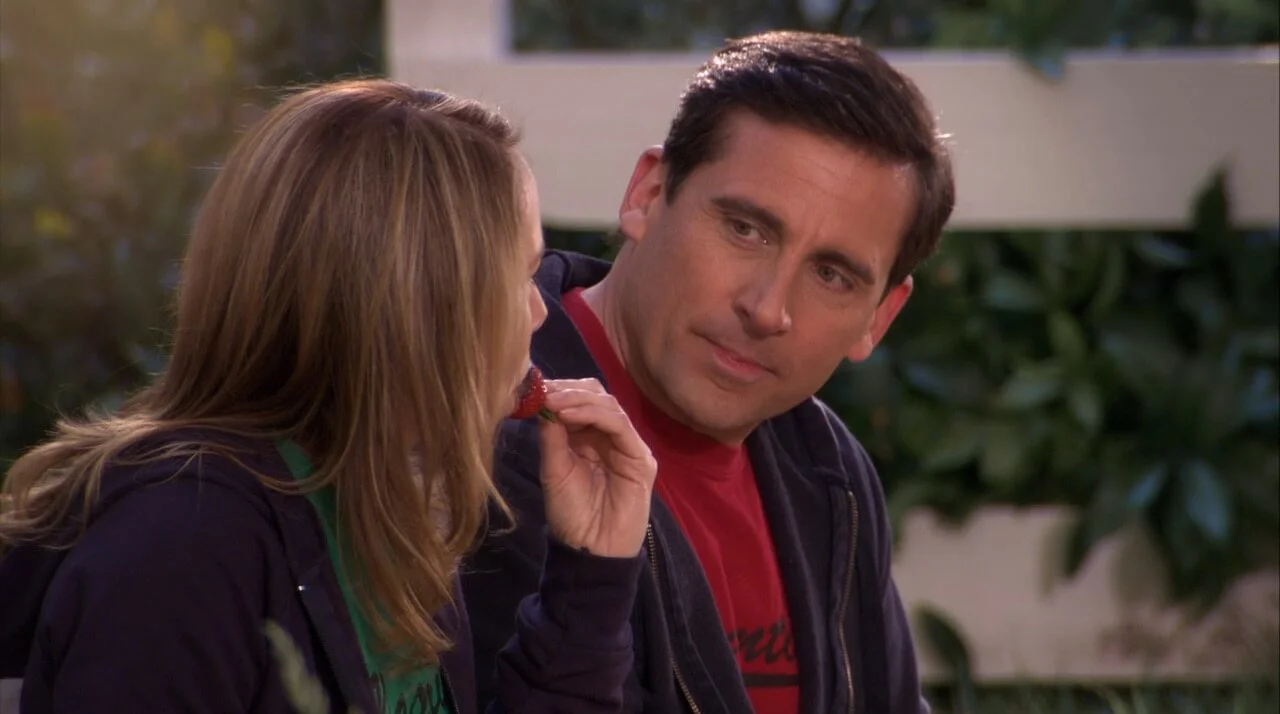
Focal Length enhances intimacy in The Role
It appears that Holly and Michael are shoulder-to-shoulder. The intimate moment, and Michael's intent, is sold with the style he looks at her when she'due south grabbing and eating her strawberry.
If you picket the scene, information technology'due south clear he's still in dearest with her. The shot helps visually communicate this information to the audience.
Go a voyeur
Longer focal lengths isolate a subject from the background. This perspective is very different from how we normally perceive the globe.
Because of these furnishings, a longer lens tin create the sense that a character is being spied on (particularly when combined with other techniques).
This can be literal, or done so the audition has a sense that they're watching a private moment.
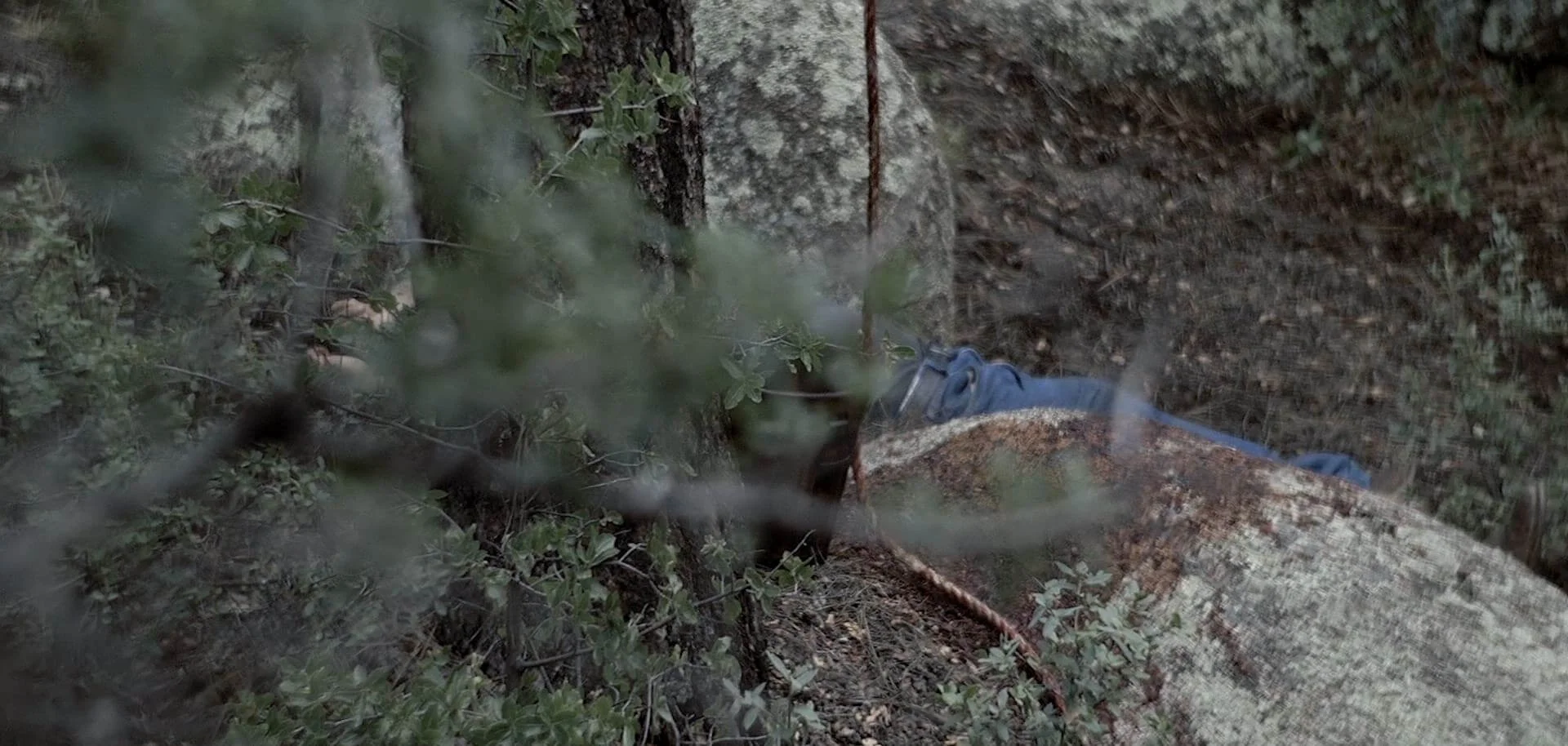
Long focal length in a brusk moving-picture show: Sacramentum
In this frame from the short film Sacramentum, a combination of techniques requite the feeling that something secretive is going on.
Specifically, a cultist has dragged a human into the forest to cede. Looking down at the unconscious man from above (similar a security camera), with a long lens (similar binoculars), and with objects in the foreground (as if someone is watching), all enhance this feeling.
2.2 long FOCAL LENGTH
Aggrandize Space
Wider focal lengths exaggerate the appearance of altitude betwixt objects. In other words, they actually accept the normal perspective you have that objects get larger every bit they become closer, and smaller as they go further, and intensify this difference.
Employ broad focal lengths to do the post-obit.
Enrich setting
Here's a buzzworthy example of broad-angle lenses expanding space. Watch the trailer for The Favourite below, and count how many times wider focal lengths (and even fisheye lens shots) enrich the world of early 18th century England.
Cheque out how the fisheye lens expands infinite in the trailer for The Favourite
The far objects appear fifty-fifty smaller, and the closer objects even larger, than they would usually appear to the homo eye.
This includes causing backgrounds to announced further away compared to normal and long focal lengths. This is often used for landscape and architecture equally information technology enhances the existing shapes and leading lines of the image to create visual involvement.
Isolate characters
Since wider focal lengths exaggerate the size of things shut to frame, this tin can give the audience a sense that they are right at that place next to your character, up close and personal.
Wide focal lengths convey isolation in a sci-fi micro film
Information technology's a more objective perspective for the audience to experience because this perspective is like sitting next to a friend.
Using a long lens would accept flattened the features on his face, giving the audience the impression that they are watching him from afar, as opposed to experiencing events with him.
It's a adequately subtle difference, but all your small visual choices will add together up. In fact, y'all could accomplish the opposite effect — making your character seem lonely — by using a wide angle lens to exaggerate the perception of the space they are in, making them announced pocket-size.
ii.3 FOCAL LENGTH: Creative TOOL
Capture Activeness
Longer focal lengths exaggerate lateral motion. That is, movement perpendicular to the camera volition be intensified past increasing the perceived speed of a subject area compared to its groundwork.
Why is this?
Reason number i is that due to compression of space with longer focal lengths, the subject in the frame appears to be moving more rapidly confronting its background.
We can't explain this much better than past showing you lot this bully scene from Fast & Furious. The filmmakers use this lateral activeness technique throughout the picture, simply at that place are some peachy examples in this particular scene.
The focal length definition is on the motion in Fast & Furious
The other reason is that due to the magnification of longer lenses, even the slightest movement by the camera operator can be profoundly exaggerated. Combined with visual pinch, this results in photographic camera shake which can be a desirable event that creates a sense of urgency and free energy.
Withal, information technology is easily overused and can be too disorienting for the audience if used excessively, and so go on this in listen.
ii.4 FOCAL LENGTH in motion
Exaggerate Movement
Wide lenses and shorter focal lengths increase the perception of speed when a bailiwick is moving toward or away from photographic camera.
This is a sort of side event from the fact that broad lenses exaggerate the altitude betwixt objects. Since closer objects announced larger, the wider your lens, the more quickly an object grows in the frame as it approaches.
Lens size heightens the chase in Minority Report
This increases the perception of speed when something moves away or toward camera. Since wide lens exaggerates distance to photographic camera, to create more than intense event of moving toward or away from photographic camera, you lot need to apply a broad angle lens.
A secondary event of broad lenses is that they minimize the perception of photographic camera shake, thereby smoothing out your shot.
Wide lenses can exist used to exaggerate the following.
Speed of characters
Pes chases are again a slap-up case of how to use wide lenses to your reward. If yous'd like to evidence the baddie chasing your hero through a hallway, you tin can make their movements appear faster than they are by using this technique.
Running the focal distance in No Way Out
This not only makes the scene more exciting, but it raises the stakes for your hero because you near experience that they cannot escape.
Movement of objects
Of course, exaggerating the rapid approach of a person isn't the just application. It works with pretty much anything including cars.
Focal length in focus in American Graffiti
Having something like a car approaching the audition at rapid speeds adds intensity to your scene.
Facial features
Since long and broad lenses compress or exaggerate the perception of how close an object is to frame, this too affects how faces look in the frame.
For example, facial features volition be evened out in proportion, or 'flattened', by longer lenses. On the other hand, wider lenses tend to exaggerate facial features, or at least whatever is closest to the lens at the time.
Of class, if your subject field is pretty far from the photographic camera, this effect won't be very noticeable, if at all, just if the discipline is shut, it will have a significant touch on on your image.
ii.v CHANGE PERSPECTIVE
Move the Photographic camera
When you add camera movement, things get more complicated, as you are then changing the perspective of the audience past physically changing proximity to objects, subjects, and your background.
You may be excited to film a big tracking shot in your next project, which means you lot'll be moving the camera with your subject.
Think about how you want the viewer to feel, so brand focal length, camera stability, motion speed, and production design to generate that intended feeling. The more thoughtful, the better the result.
Movement the camera and use different lenses to tell your story
Depending on what lens you are using, your paradigm will so change according to the effect that focal length creates.
That is why it's so important to learn the unlike furnishings that focal length has on your epitome, and ultimately, your audience.
When you know how to use the tools available to you, yous can twist them to your purposes, such as for comedic effect.
A unique technique that uses the power of focal length and camera motility is the the famous "vertigo" effect popularized by filmmakers such as Alfred Hitchcock and later Stephen Spielberg.
Dolly zoom and focal length can cause vertigo
The reason this effect is possible is because it is using the human relationship between how the lens compresses the image and the concrete movement of the photographic camera in unison to warp the visual perspective.
Another utilize is the iconic 'Bayhem' shot, which adds drama to a shot.
It creates parallax movement and depth past having the subject field move contrary the management the camera is moving, with a long lens, which exaggerates the motion.
The background appears to whip past the actor due to image compression.
Michael Bay uses focal length to bring the "Bayhem"
Your camera and lens are the audience. Your audience sees no more and no less than what you show them. It is crucial that when telling your story, you consider all the aspects of visual storytelling for your film.
All the small artistic storytelling choices that you brand for each image of your flick are important. These pocket-size choices coagulate into the powerful effects your audience will feel as your story unfolds before them.
Gratis downloadable bonus
FREE Download
Camera Lenses Explained
Every type of camera lens has singled-out qualities and visual characteristics that every paradigm-maker should understand. Download our FREE e-book to become in-depth explanations on prime vs. zoom lenses, anamorphic vs. spherical lenses, wide angle, standard, telephoto and even specialty lenses that all tell a slightly dissimilar story.

UP Side by side
Understanding Depth of Field
Now that you have a better grasp on focal lengths, check out our post, The Essential Guide to Depth of Field.
Depth of field and focal length are some of the most powerful visual tools for whatsoever filmmaker, regardless of whether you lot are shooting music videos, television shows, or online content.
Up Next: Guide to Depth of Field →
Showcase your vision with elegant shot lists and storyboards.
Create robust and customizable shot lists. Upload images to make storyboards and slideshows.
Learn More ➜
Source: https://www.studiobinder.com/blog/focal-length-camera-lenses-explained/#:~:text=Focal%20length%20is%20the%20distance,view%20for%20a%20given%20lens.
Posted by: browndowerturs.blogspot.com


0 Response to "Focal Length Defines Which Of The Following Camera Qualities?"
Post a Comment